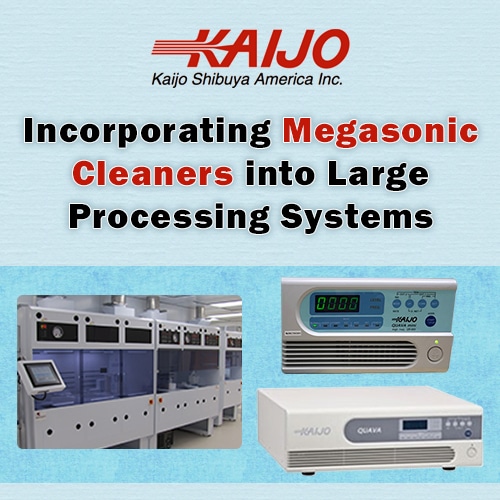Incorporating Megasonic Cleaners into Large Processing Systems
May 5, 2021
 As production part cleaning requirements become more stringent, environmental regulations are restricting the use of the aggressive chemicals commonly used in large processing systems. Manufacturing lines often incorporate cleaning steps to prepare parts for subsequent processing. Cleaning may include manual scrubbing, pressure washing and soaking in hot chemical baths. Modern products often include heat-sensitive components, fragile sensors and parts with delicate surfaces that could be damaged by traditional cleaning methods. When these methods include soaking in acid mixtures or toxic solvents, disposal in accordance with local regulations becomes more and more difficult.
As production part cleaning requirements become more stringent, environmental regulations are restricting the use of the aggressive chemicals commonly used in large processing systems. Manufacturing lines often incorporate cleaning steps to prepare parts for subsequent processing. Cleaning may include manual scrubbing, pressure washing and soaking in hot chemical baths. Modern products often include heat-sensitive components, fragile sensors and parts with delicate surfaces that could be damaged by traditional cleaning methods. When these methods include soaking in acid mixtures or toxic solvents, disposal in accordance with local regulations becomes more and more difficult.
Megasonic cleaning systems provide the best alternative for removing contaminants from the surfaces of parts or devices that need to be cleaned without the use of harsh chemicals. Cleaning can take place at room temperature and the process is completely safe, requiring no additional operator safety measures. As a result, Megasonic cleaning can easily be incorporated into a production line. No special support equipment is needed and the cleaners work without requiring operator monitoring. For manufacturers wishing to reduce the use of expensive and toxic chemicals while improving the performance of their cleaning stations, Megasonic cleaners can also be incorporated into larger processing systems to provide an effective solution.
How Wet Bench Semiconductor Processing Incorporates Megasonic Cleaning
One area megasonic cleaners are incorporated into larger processing systems is in wet bench chemical stations used by semiconductor manufacturers. Semiconductor manufacturers process silicon wafers by etching the silicon and depositing conducting layers to form electronic components. The wafers frequently have to be cleaned between the process steps so that wafer contamination with unwanted substances does not interfere with the process. Cleaning silicon wafers is commonly carried out in baths containing chemicals such as hydrochloric acid, sulfuric acid and hydrogen peroxide.
The cleaning chemicals are dangerous, toxic and expensive. They require chemical delivery systems to fill the cleaning tanks and disposal systems for the used chemical mixtures. Special measures for chemical storage and operator safety have to be put in place. Chemicals represent a major expense for semiconductor manufacturing. As local jurisdictions raise environmental standards for disposal of the chemicals and as worker safety regulations become more stringent, the cost of using the chemicals has become more expensive.
Incorporating Megasonic cleaning systems into the semiconductor production line reduces chemical use and improves cleaning performance. While chemical cleaning methods rely on soaking and chemical action to remove contaminants, Megasonic cleaning works mechanically.
The sound waves of Megasonic cleaning systems create microscopic cavitation bubbles when the sound waves pass through the cleaning solution. The scrubbing action of the bubbles as they form and burst dislodges contaminants and allows them to be rinsed away. This cleaning mechanism is especially effective for hard-to-remove microscopic particles that can cause semiconductor component defects. Incorporating the Megasonic cleaning method produces silicon wafers that have fewer contaminating particles.
Using Megasonic cleaning to displace some of the other cleaning methods has been implemented successfully in the semiconductor manufacturing industry. Facilities that have installed Megasonic cleaning save money from reduced chemical use and lower costs for chemical disposal. Megasonic cleaning is often faster than cleaning with chemicals, improving facility throughput. Silicon wafers cleaned with a Megasonic cleaning system will have a lower particle count, resulting in fewer defective components and a higher process yield. Overall, costs are reduced and output quality is improved.
Kaijo Can Incorporate Megasonic Cleaning into Large Industrial Production Lines
Kaijo is building on the company’s experience with wet process semiconductor manufacturing to incorporate Megasonic cleaning in other manufacturing systems. Kaijo’s Megasonic cleaners can be customized to fit into most industrial processes that require periodic cleaning of parts, and the company is working closely with equipment manufacturers to identify cleaning solutions for their facilities. Customers are attracted to the new cleaning technology because it promises to lower costs while creating a safer workplace and a more environmentally-friendly operation.





